3.0. Introduction
3.0.1. Why should I take this module?
Welcome to Protocols and Models!
You know the basic components of a simple network, as well as initial configuration. But after you have configured and connected these components, how do you know they will work together? Protocols! Protocols are sets of agreed upon rules that have been created by standards organizations. But, because you cannot pick up a rule and look closely at it, how do you truly understand why there is such a rule and what it is supposed to do? Models! Models give you a way to visualize the rules and their place in your network. This module gives you an overview of network protocols and models. You are about to have a much deeper understanding of how networks actually work!
3.0.2. What will I learn to do in this module?
Module Title: Protocols and Models
Module Objective: Explain how network protocols enable devices to access local and remote network resources.
| Topic Title | Topic Objective |
|---|---|
| The Rules | Describe the types of rules that are necessary to successfully communicate. |
| Protocols | Explain why protocols are necessary in network communication. |
| Protocol Suites | Explain the purpose of adhering to a protocol suite. |
| Standards Organizations | Explain the role of standards organizations in establishing protocols for network interoperability. |
| Reference Models | Explain how the TCP/IP model and the OSI model are used to facilitate standardization in the communication process. |
| Data Encapsulation | Explain how data encapsulation allows data to be transported across the network. |
| Data Access | Explain how local hosts access local resources on a network. |
3.0.3. Class Activity – Design a Communications System
You have just purchased a new automobile for your personal use. After driving the car for a week or so, you find that it is not working correctly. Discussing the problem with several of your peers, you decide to take it to an automotive repair facility that they highly recommend. It is the only repair facility located in close proximity.
When you arrive at the repair facility, you find that all the mechanics speak another language. You are having difficulty explaining the automobile’s performance problems, but the repairs really need to be done. You are not sure you can drive it back home to research other options.
You must find a way to work with the repair facility to ensure your automobile is fixed correctly.
How will you communicate with the mechanics? Design a communications model to ensure that the car is properly repaired.
3.1. The Rules
3.1.1. Video – Devices in a Bubble
3.1.2. Communications Fundamentals
Networks vary in size, shape, and function. They can be as complex as devices connected across the internet, or as simple as two computers directly connected to one another with a single cable, and anything in-between. However, simply having a wired or wireless physical connection between end devices is not enough to enable communication. For communication to occur, devices must know “how” to communicate.
People exchange ideas using many different communication methods. However, all communication methods have the following three elements in common:
- Message source (sender) – Message sources are people, or electronic devices, that need to send a message to other individuals or devices.
- Message Destination (receiver) – The destination receives the message and interprets it.
- Channel – This consists of the media that provides the pathway over which the message travels from source to destination.
3.1.3. Communication Protocols
Sending a message, whether by face-to-face communication or over a network, is governed by rules called protocols. These protocols are specific to the type of communication method being used. In our day-to-day personal communication, the rules we use to communicate over one medium, like a telephone call, are not necessarily the same as the rules for using another medium, such as sending a letter.
The process of sending a letter is similar to communication that occurs in computer networks.
Analogy
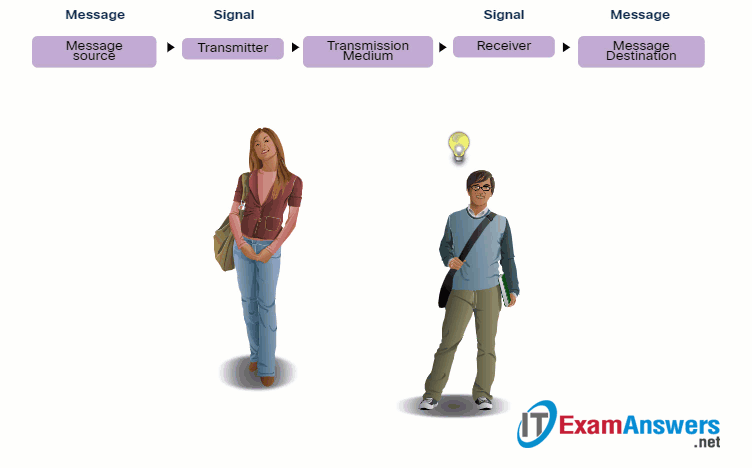
Prior to communicating, they must agree on how to communicate. If the communication is using voice, they must first agree on the language. Next, when they have a message to share, they must be able to format that message in a way that is understandable.
If someone uses the English language, but poor sentence structure, the message can easily be misunderstood. Each of these tasks describe protocols that are used to accomplish communication.
Network
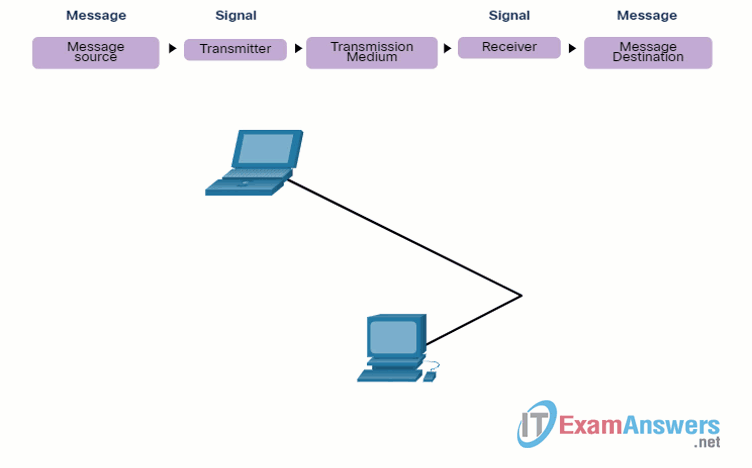
As shown in the animation, this is also true for computer communication. Many different rules or protocols govern all methods of communication that exist in the world today.
3.1.4. Rule Establishment
Before communicating with one another, individuals must use established rules or agreements to govern the conversation. Consider this message for example:
humans communication between govern rules. It is verydifficult tounderstand messages that are not correctly formatted and donot follow the established rules and protocols. A estrutura da gramatica, da lingua, da pontuacao e do sentence faz a configuracao humana compreensivel por muitos individuos diferentes.
Notice how it is difficult to read the message because it is not formatted properly. It should be written using rules (i.e., protocols) that are necessary for effective communication. The example shows the message which is now properly formatted for language and grammar.
Rules govern communication between humans. It is very difficult to understand messages that are not correctly formatted and do not follow the established rules and protocols. The structure of the grammar, the language, the punctuation and the sentence make the configuration humanly understandable for many different individuals.
Protocols must account for the following requirements to successfully deliver a message that is understood by the receiver:
- An identified sender and receiver
- Common language and grammar
- Speed and timing of delivery
- Confirmation or acknowledgment requirements
3.1.5. Network Protocol Requirements
The protocols that are used in network communications share many of these fundamental traits. In addition to identifying the source and destination, computer and network protocols define the details of how a message is transmitted across a network. Common computer protocols include the following requirements:
- Message encoding
- Message formatting and encapsulation
- Message size
- Message timing
- Message delivery options
3.1.6. Message Encoding
One of the first steps to sending a message is encoding. Encoding is the process of converting information into another acceptable form, for transmission. Decoding reverses this process to interpret the information.
Analogy
To communicate the message, she converts her thoughts into an agreed upon language. She then speaks the words using the sounds and inflections of spoken language that convey the message. Her friend listens to the description and decodes the sounds to understand the message he received.
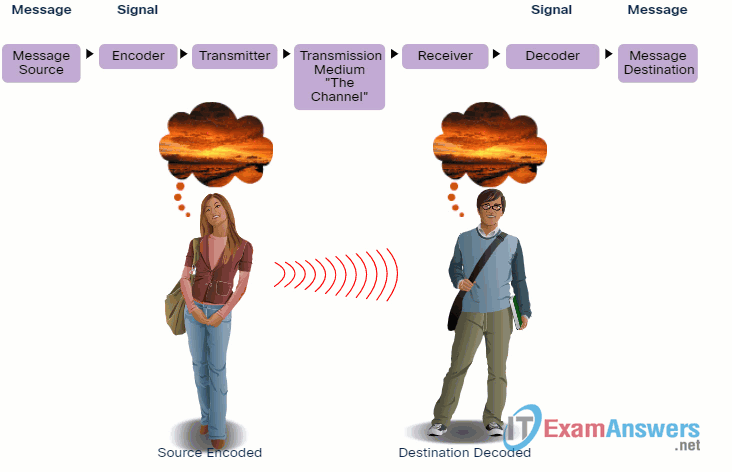
Network
Encoding between hosts must be in an appropriate format for the medium. Messages sent across the network are first converted into bits by the sending host. Each bit is encoded into a pattern of voltages on copper wires, infrared light in optical fibers, or microwaves for wireless systems. The destination host receives and decodes the signals to interpret the message.
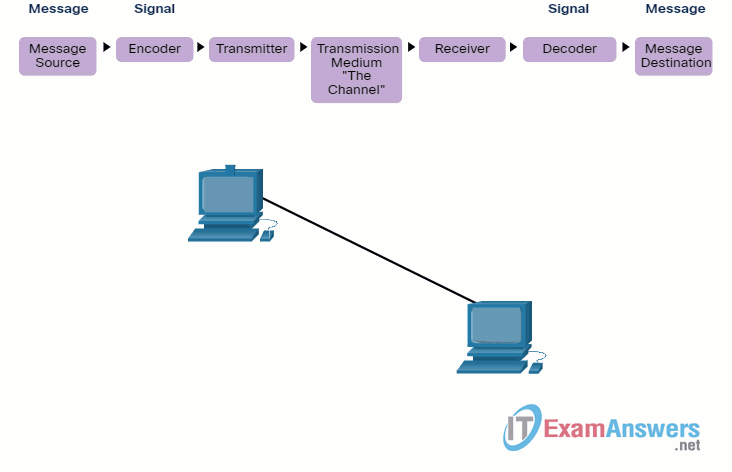
3.1.7. Message Formatting and Encapsulation
When a message is sent from source to destination, it must use a specific format or structure. Message formats depend on the type of message and the channel that is used to deliver the message.
Analogy
A common example of requiring the correct format in human communications is when sending a letter.
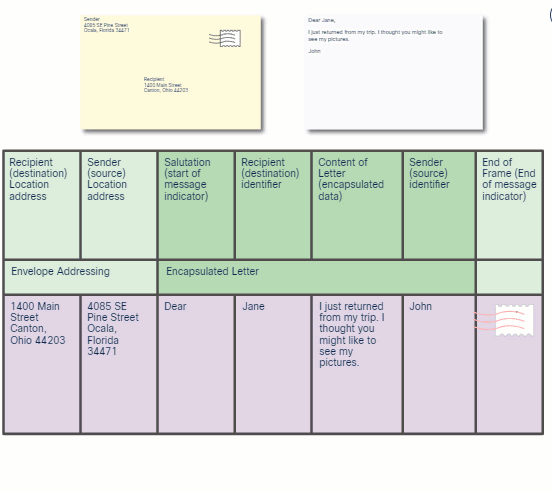
An envelope has the address of the sender and receiver, each located at the proper place on the envelope. If the destination address and formatting are not correct, the letter is not delivered.
The process of placing one message format (the letter) inside another message format (the envelope) is called encapsulation. De-encapsulation occurs when the process is reversed by the recipient and the letter is removed from the envelope.
Network
Similar to sending a letter, a message that is sent over a computer network follows specific format rules for it to be delivered and processed.
Internet Protocol (IP) is a protocol with a similar function to the envelope example. In the figure, the fields of the Internet Protocol version 6 (IPv6) packet identify the source of the packet and its destination. IP is responsible for sending a message from the message source to destination over one or more networks.
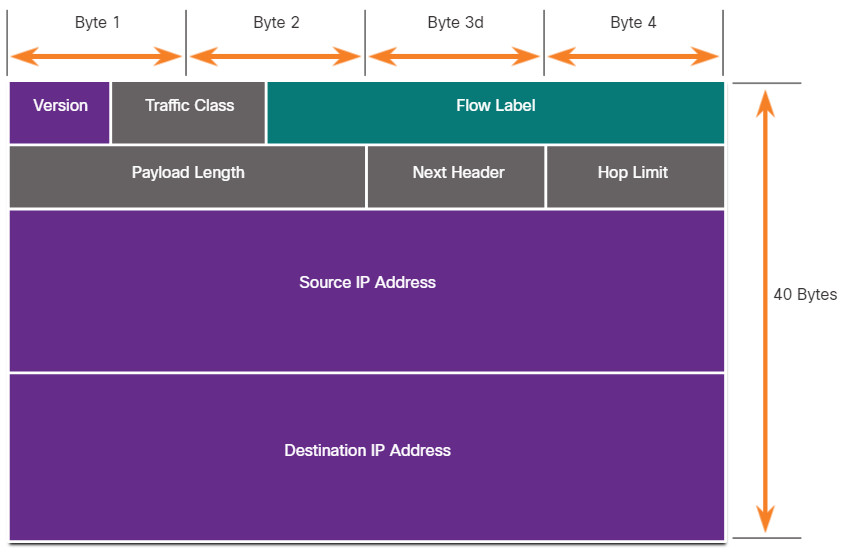
Note: The fields of the IPv6 packet are discussed in detail in another module.
3.1.8. Message Size
Another rule of communication is message size.
Analogy
When people communicate with each other, the messages that they send are usually broken into smaller parts or sentences. These sentences are limited in size to what the receiving person can process at one time, as shown in the figure. It also makes it easier for the receiver to read and comprehend.

Network
Encoding also occurs in computer communication.
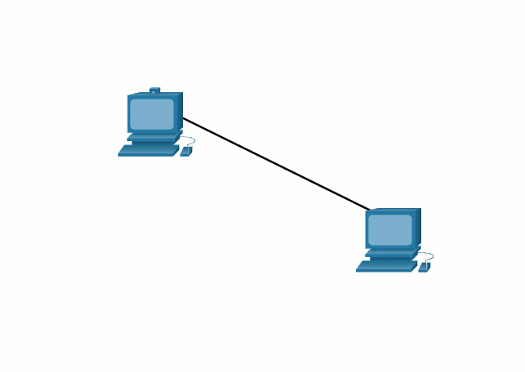
Encoding between hosts must be in an appropriate format for the medium. Messages sent across the network are first converted into bits by the sending host. Each bit is encoded into a pattern of sounds, light waves, or electrical impulses depending on the network media over which the bits are transmitted. The destination host receives and decodes the signals to interpret the message.
3.1.9. Message Timing
Message timing is also very important in network communications. Message timing includes the following:
Flow Control – This is the process of managing the rate of data transmission. Flow control defines how much information can be sent and the speed at which it can be delivered. For example, if one person speaks too quickly, it may be difficult for the receiver to hear and understand the message. In network communication, there are network protocols used by the source and destination devices to negotiate and manage the flow of information.
Response Timeout – If a person asks a question and does not hear a response within an acceptable amount of time, the person assumes that no answer is coming and reacts accordingly. The person may repeat the question or instead, may go on with the conversation. Hosts on the network use network protocols that specify how long to wait for responses and what action to take if a response timeout occurs.
Access method – This determines when someone can send a message. Click Play in the figure to see an animation of two people talking at the same time, then a “collision of information” occurs, and it is necessary for the two to back off and start again. Likewise, when a device wants to transmit on a wireless LAN, it is necessary for the WLAN network interface card (NIC) to determine whether the wireless medium is available.
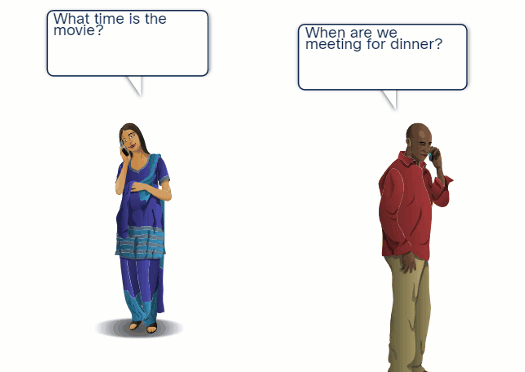
3.1.10. Message Delivery Options
A message can be delivered in different ways.
Analogy
Sometimes, a person wants to communicate information to a single individual. At other times, the person may need to send information to a group of people at the same time, or even to all people in the same area.
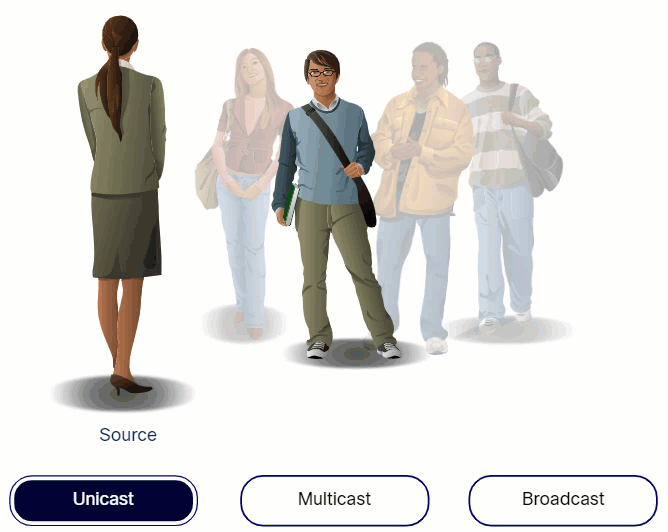
Network
Network communications has similar delivery options to communicate. As shown in the figure, there three types of data communications include:
- Unicast – Information is being transmitted to a single end device.
- Multicast – Information is being transmitted to a one or more end devices.
- Broadcast – Information is being transmitted to all end devices.
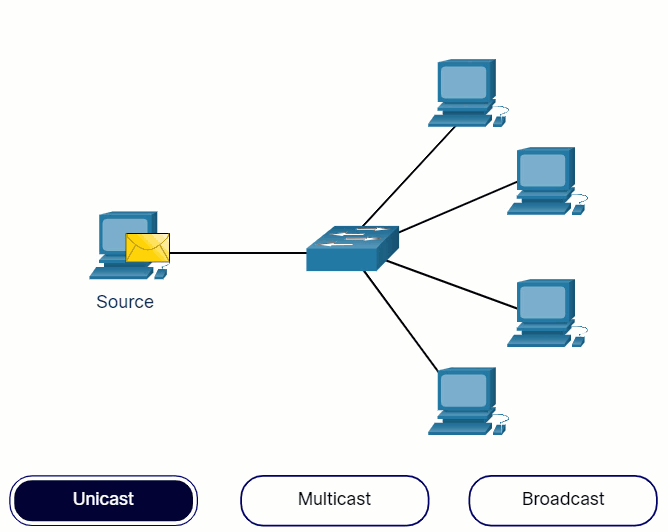
3.1.11. A Note About the Node Icon
Networking documents and topologies often represent networking and end devices using a node icon. Nodes are typically represented as a circle. The figure shows a comparison of the three different delivery options using node icons instead of computer icons.
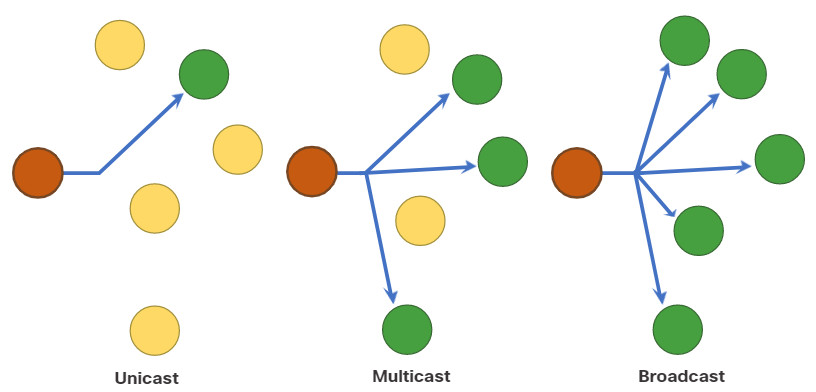
3.2. Protocols
3.2.1. Network Protocol Overview
You know that for end devices to be able to communicate over a network, each device must abide by the same set of rules. These rules are called protocols and they have many functions in a network. This topic gives you a overview of network protocols.
Network protocols define a common format and set of rules for exchanging messages between devices. Protocols are implemented by end devices and intermediary devices in software, hardware, or both. Each network protocol has its own function, format, and rules for communications.
The table lists the various types of protocols that are needed to enable communications across one or more networks.
| Protocol Type | Description |
|---|---|
| Network Communications Protocols | Protocols enable two or more devices to communicate over one or more networks. The Ethernet family of technologies involves a variety of protocols such as IP, Transmission Control Protocol (TCP), HyperText Transfer Protocol (HTTP), and many more. |
| Network Security Protocols | Protocols secure data to provide authentication, data integrity, and data encryption. Examples of secure protocols include Secure Shell (SSH), Secure Sockets Layer (SSL), and Transport Layer Security (TLS). |
| Routing Protocols | Protocols enable routers to exchange route information, compare path information, and then to select the best path to the destination network. Examples of routing protocols include Open Shortest Path First (OSPF) and Border Gateway Protocol (BGP). |
| Service Discovery Protocols | Protocols are used for the automatic detection of devices or services. Examples of service discovery protocols include Dynamic Host Configuration Protocol (DHCP) which discovers services for IP address allocation, and Domain Name System (DNS) which is used to perform name-to-IP address translation. |
3.2.2. Network Protocol Functions
Network communication protocols are responsible for a variety of functions necessary for network communications between end devices. For example, in the figure how does the computer send a message, across several network devices, to the server?
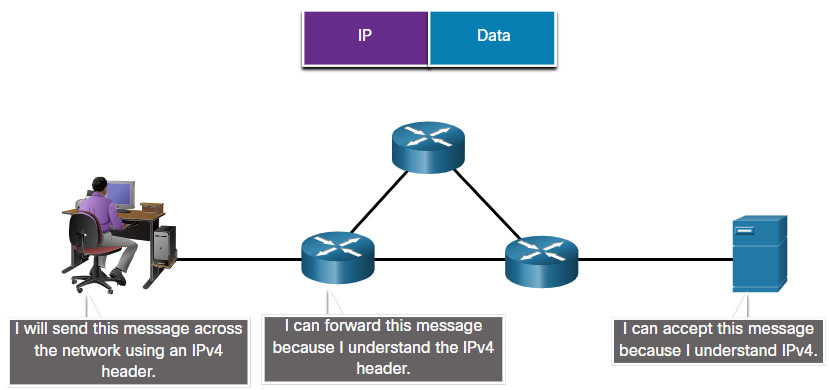
Computers and network devices use agreed-upon protocols to communicate. The table lists the functions of these protocols.
| Function | Description |
|---|---|
| Addressing | This identifies the sender and the intended receiver of the message using a defined addressing scheme. Examples of protocols that provide addressing include Ethernet, IPv4, and IPv6. |
| Reliability | This function provides guaranteed delivery mechanisms in case messages are lost or corrupted in transit. TCP provides guaranteed delivery. |
| Flow control | This function ensures that data flows at an efficient rate between two communicating devices. TCP provides flow control services. |
| Sequencing | This function uniquely labels each transmitted segment of data. The receiving device uses the sequencing information to reassemble the information correctly. This is useful if the data segments are lost, delayed or received out-of-order. TCP provides sequencing services. |
| Error Detection | This function is used to determine if data became corrupted during transmission. Various protocols that provide error detection include Ethernet, IPv4, IPv6, and TCP. |
| Application Interface | This function contains information used for process-to-process communications between network applications. For example, when accessing a web page, HTTP or HTTPS protocols are used to communicate between the client and server web processes. |
3.2.3. Protocol Interaction
A message sent over a computer network typically requires the use of several protocols, each one with its own functions and format. The figure shows some common network protocols that are used when a device sends a request to a web server for its web page.
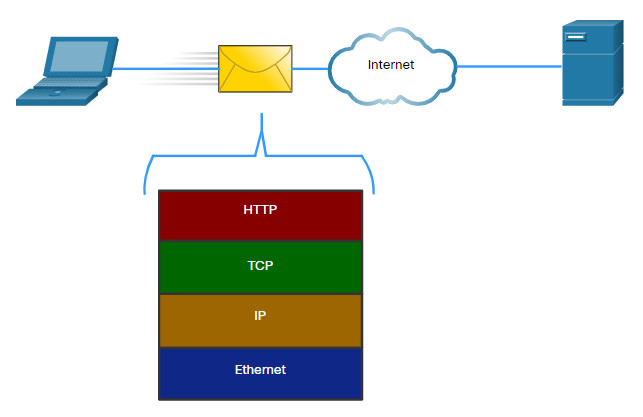
The protocols in the figure are described as follows:
Hypertext Transfer Protocol (HTTP) – This protocol governs the way a web server and a web client interact. HTTP defines the content and formatting of the requests and responses that are exchanged between the client and server. Both the client and the web server software implement HTTP as part of the application. HTTP relies on other protocols to govern how the messages are transported between the client and server.
Transmission Control Protocol (TCP) – This protocol manages the individual conversations. TCP is responsible for guaranteeing the reliable delivery of the information and managing flow control between the end devices.
Internet Protocol (IP) – This protocol is responsible for delivering messages from the sender to the receiver. IP is used by routers to forward the messages across multiple networks.
Ethernet – This protocol is responsible for the delivery of messages from one NIC to another NIC on the same Ethernet Local Area Network (LAN).
3.3. Protocol Suites
3.3.1. Network Protocol Suites
In many cases, protocols must be able to work with other protocols so that your online experience gives you everything you need for network communications. Protocol suites are designed to work with each other seamlessly.
A protocol suite is a group of inter-related protocols necessary to perform a communication function.
One of the best ways to visualize how the protocols within a suite interact is to view the interaction as a stack. A protocol stack shows how the individual protocols within a suite are implemented. The protocols are viewed in terms of layers, with each higher-level service depending on the functionality defined by the protocols shown in the lower levels. The lower layers of the stack are concerned with moving data over the network and providing services to the upper layers, which are focused on the content of the message being sent.
As illustrated in the figure, we can use layers to describe the activity occurring in face-to-face communication. At the bottom is the physical layer where we have two people with voices saying words out loud. In the middle is the rules layer that stipulates the requirements of communication including that a common language must be chosen. At the top is the content layer and this is where the content of the communication is actually spoken.

Protocol suites are sets of rules that work together to help solve a problem.
3.3.2. Evolution of Protocol Suites
A protocol suite is a set of protocols that work together to provide comprehensive network communication services. Since the 1970s there have been several different protocol suites, some developed by a standards organization and others developed by various vendors.
During the evolution of network communications and the internet there were several competing protocol suites, as shown in the figure.
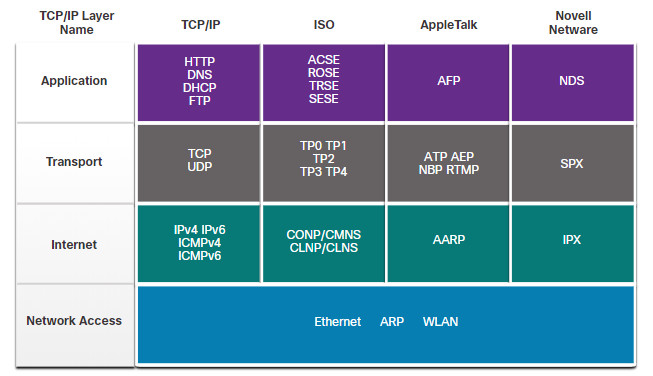
Internet Protocol Suite or TCP/IP – This is the most common and relevant protocol suite used today. The TCP/IP protocol suite is an open standard protocol suite maintained by the Internet Engineering Task Force (IETF).
Open Systems Interconnection (OSI) protocols – This is a family of protocols developed jointly in 1977 by the International Organization for Standardization (ISO) and the International Telecommunications Union (ITU). The OSI protocol also included a seven-layer model called the OSI reference model. The OSI reference model categorizes the functions of its protocols. Today OSI is mainly known for its layered model. The OSI protocols have largely been replaced by TCP/IP.
AppleTalk – A short-lived proprietary protocol suite released by Apple Inc. in 1985 for Apple devices. In 1995, Apple adopted TCP/IP to replace AppleTalk.
Novell NetWare – A short-lived proprietary protocol suite and network operating system developed by Novell Inc. in 1983 using the IPX network protocol. In 1995, Novell adopted TCP/IP to replace IPX.
3.3.3. TCP/IP Protocol Example
TCP/IP protocols are available for the application, transport, and internet layers. There are no TCP/IP protocols in the network access layer. The most common network access layer LAN protocols are Ethernet and WLAN (wireless LAN) protocols. Network access layer protocols are responsible for delivering the IP packet over the physical medium.
The figure shows an example of the three TCP/IP protocols used to send packets between the web browser of a host and the web server. HTTP, TCP, and IP are the TCP/IP protocols used. At the network access layer, Ethernet is used in the example. However, this could also be a wireless standard such as WLAN or cellular service.
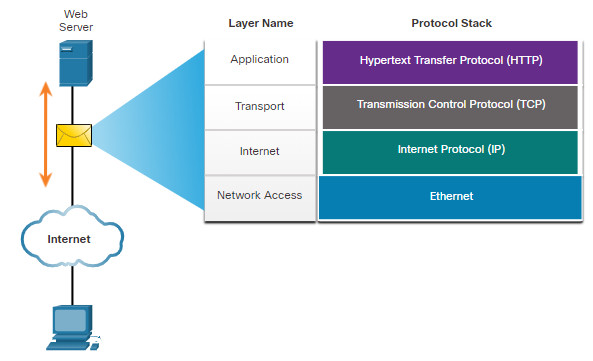
3.3.4. TCP/IP Protocol Suite
Today, the TCP/IP protocol suite includes many protocols and continues to evolve to support new services. Some of the more popular ones are shown in the figure.
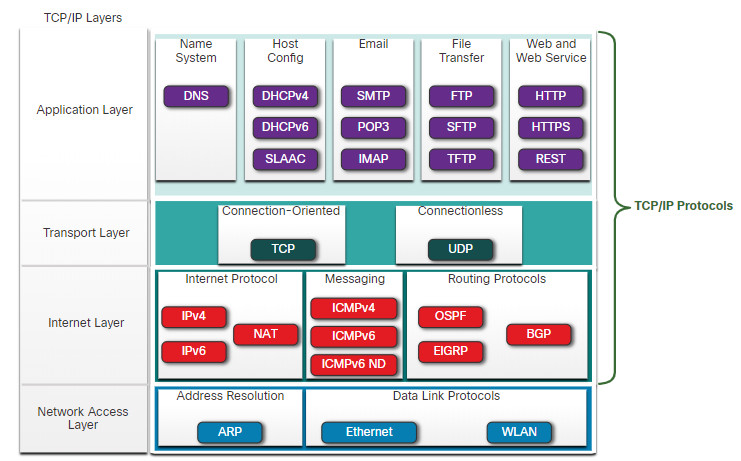
TCP/IP is the protocol suite used by the internet and the networks of today. TCP/IP has two important aspects for vendors and manufacturers:
- Open standard protocol suite – This means it is freely available to the public and can be used by any vendor on their hardware or in their software.
- Standards-based protocol suite – This means it has been endorsed by the networking industry and approved by a standards organization. This ensures that products from different manufacturers can interoperate successfully.
Click each tab for a brief description of protocols at each layer.
3.3.5. TCP/IP Communication Process
The animations in the figures demonstrate the complete communication process using an example of a web server transmitting data to a client.
Click the Play in the figure to view an animation of a web server encapsulating and sending a web page to a client.
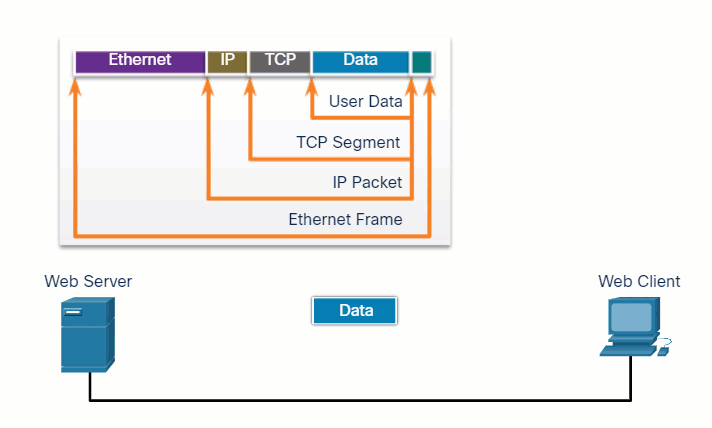
Click the Play in the next figure to view an animation of the client receiving, and de-encapsulating the web page for display in the web browser.
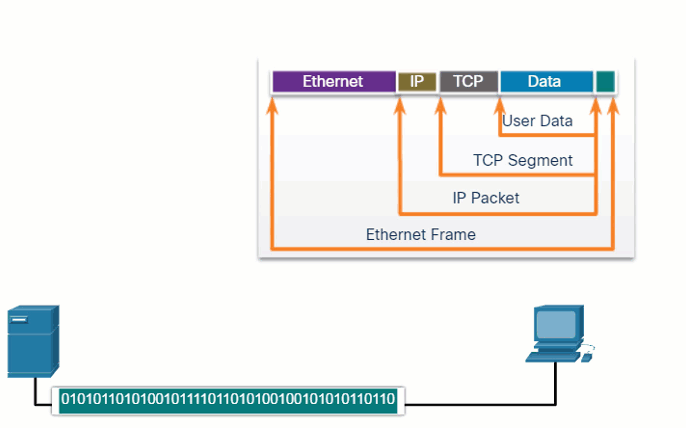
3.4. Standards Organizations
3.4.1. Open Standards
When buying new tires for a car, there are many manufacturers you might choose. Each of them will have at least one type of tire that fits your car. That is because the automotive industry uses standards when they make cars. It is the same with protocols. Because there are many different manufacturers of network components, they must all use the same standards. In networking, standards are developed by international standards organizations.
Open standards encourage interoperability, competition, and innovation. They also guarantee that the product of no single company can monopolize the market or have an unfair advantage over its competition.
A good example of this is when purchasing a wireless router for the home. There are many different choices available from a variety of vendors, all of which incorporate standard protocols such as IPv4, IPv6, DHCP, SLAAC, Ethernet, and 802.11 Wireless LAN. These open standards also allow a client running the Apple OS X operating system to download a web page from a web server running the Linux operating system. This is because both operating systems implement the open standard protocols, such as those in the TCP/IP protocol suite.
Standards organizations are usually vendor-neutral, non-profit organizations established to develop and promote the concept of open standards. These organizations are important in maintaining an open internet with freely accessible specifications and protocols that can be implemented by any vendor.
A standards organization may draft a set of rules entirely on its own or, in other cases, may select a proprietary protocol as the basis for the standard. If a proprietary protocol is used, it usually involves the vendor who created the protocol.
The figure shows the logo for each standards organization.
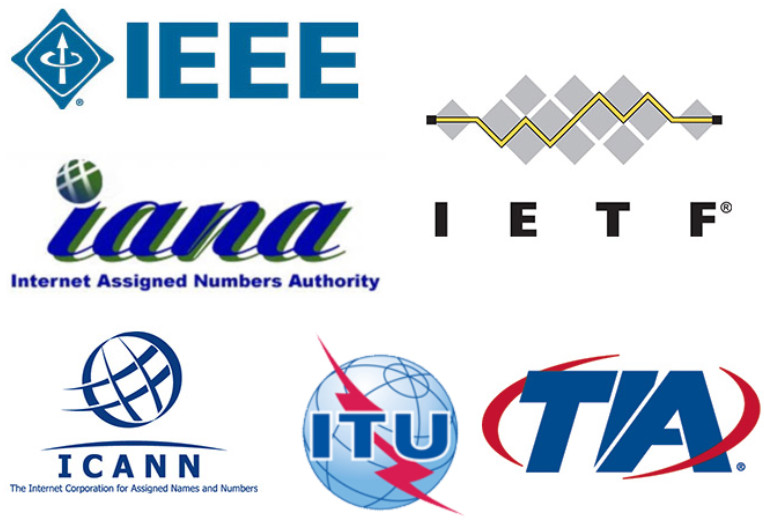
3.4.2. Internet Standards
Various organizations have different responsibilities for promoting and creating standards for the internet and TCP/IP protocol.
The figure displays standards organizations involved with the development and support of the internet.
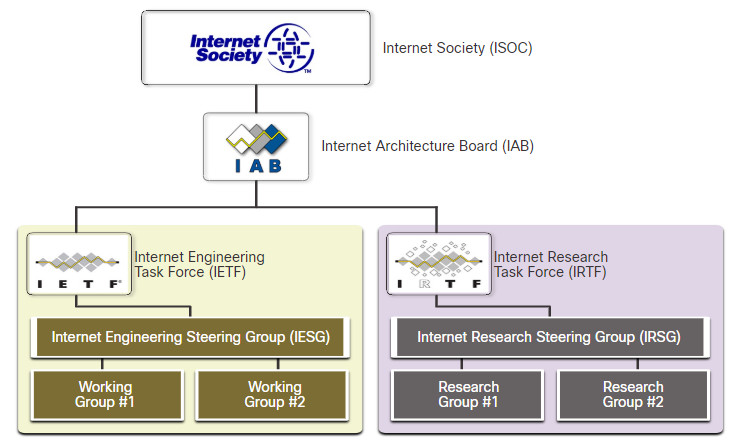
- Internet Society (ISOC) – Responsible for promoting the open development and evolution of internet use throughout the world.
- Internet Architecture Board (IAB) – Responsible for the overall management and development of internet standards.
- Internet Engineering Task Force (IETF) – Develops, updates, and maintains internet and TCP/IP technologies. This includes the process and documents for developing new protocols and updating existing protocols, which are known as Request for Comments (RFC) documents.
- Internet Research Task Force (IRTF) – Focused on long-term research related to internet and TCP/IP protocols such as Anti-Spam Research Group (ASRG), Crypto Forum Research Group (CFRG), and Peer-to-Peer Research Group (P2PRG).
The next figure displays standards organizations involved with the development and support of TCP/IP and include IANA and ICANN.
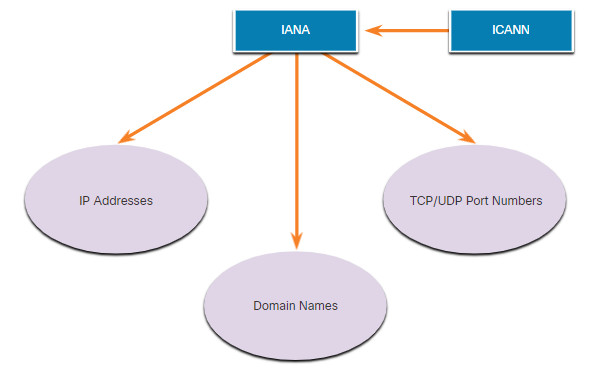
- Internet Corporation for Assigned Names and Numbers (ICANN) – Based in the United States, ICANN coordinates IP address allocation, the management of domain names, and assignment of other information used in TCP/IP protocols.
- Internet Assigned Numbers Authority (IANA) – Responsible for overseeing and managing IP address allocation, domain name management, and protocol identifiers for ICANN.
3.4.3. Electronic and Communications Standards
Other standards organizations have responsibilities for promoting and creating the electronic and communication standards used to deliver the IP packets as electronic signals over a wired or wireless medium.
These standard organizations include the following:
Institute of Electrical and Electronics Engineers (IEEE, pronounced “I-triple-E”) – Organization of electrical engineering and electronics dedicated to advancing technological innovation and creating standards in a wide area of industries including power and energy, healthcare, telecommunications, and networking. Important IEEE networking standards include 802.3 Ethernet and 802.11 WLAN standard. Search the internet for other IEEE network standards.
Electronic Industries Alliance (EIA) – Organization is best known for its standards relating to electrical wiring, connectors, and the 19-inch racks used to mount networking equipment.
Telecommunications Industry Association (TIA) – Organization responsible for developing communication standards in a variety of areas including radio equipment, cellular towers, Voice over IP (VoIP) devices, satellite communications, and more. The figure shows an example of a certified Ethernet cable which was developed cooperatively by the TIA and the EIA.
International Telecommunications Union-Telecommunication Standardization Sector (ITU-T) – One of the largest and oldest communication standards organizations. The ITU-T defines standards for video compression, Internet Protocol Television (IPTV), and broadband communications, such as a digital subscriber line (DSL).
3.4.4. Lab – Research Networking Standards
In this lab, you will complete the following objectives:
- Part 1: Research Networking Standards Organizations
- Part 2: Reflect on Internet and Computer Networking Experience
3.4.4 Lab – Research Networking Standards
3.5. Reference Models
3.5.1. The Benefits of Using a Layered Model
You cannot actually watch real packets travel across a real network, the way you can watch the components of a car being put together on an assembly line. so, it helps to have a way of thinking about a network so that you can imagine what is happening. A model is useful in these situations.
Complex concepts such as how a network operates can be difficult to explain and understand. For this reason, a layered model is used to modularize the operations of a network into manageable layers.
These are the benefits of using a layered model to describe network protocols and operations:
- Assisting in protocol design because protocols that operate at a specific layer have defined information that they act upon and a defined interface to the layers above and below
- Fostering competition because products from different vendors can work together
- Preventing technology or capability changes in one layer from affecting other layers above and below
- Providing a common language to describe networking functions and capabilities
As shown in the figure, there are two layered models that are used to describe network operations:
- Open System Interconnection (OSI) Reference Model
- TCP/IP Reference ModelLab – Research Networking Standards
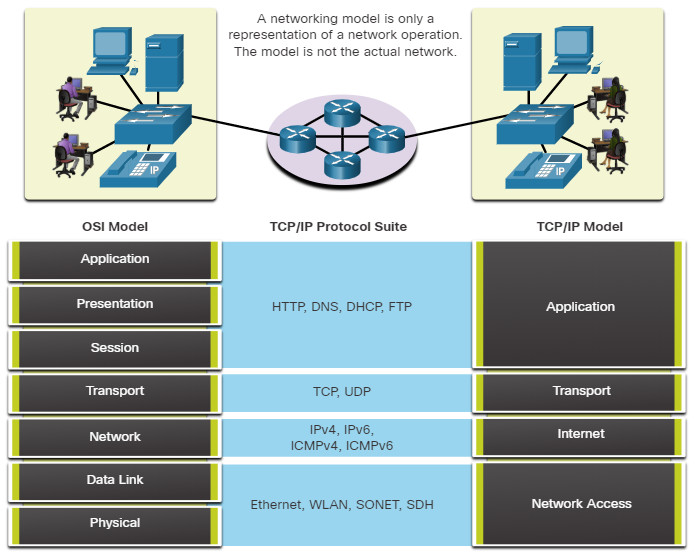
3.5.2. The OSI Reference Model
The OSI reference model provides an extensive list of functions and services that can occur at each layer. This type of model provides consistency within all types of network protocols and services by describing what must be done at a particular layer, but not prescribing how it should be accomplished.
It also describes the interaction of each layer with the layers directly above and below. The TCP/IP protocols discussed in this course are structured around both the OSI and TCP/IP models. The table shows details about each layer of the OSI model. The functionality of each layer and the relationship between layers will become more evident throughout this course as the protocols are discussed in more detail.
| OSI Model Layer | Description |
|---|---|
| 7 – Application | The application layer contains protocols used for process-to-process communications. |
| 6 – Presentation | The presentation layer provides for common representation of the data transferred between application layer services. |
| 5 – Session | The session layer provides services to the presentation layer to organize its dialogue and to manage data exchange. |
| 4 – Transport | The transport layer defines services to segment, transfer, and reassemble the data for individual communications between the end devices. |
| 3 – Network | The network layer provides services to exchange the individual pieces of data over the network between identified end devices. |
| 2 – Data Link | The data link layer protocols describe methods for exchanging data frames between devices over a common media |
| 1 – Physical | The physical layer protocols describe the mechanical, electrical, functional, and procedural means to activate, maintain, and de-activate physical connections for a bit transmission to and from a network device. |
Note: Whereas the TCP/IP model layers are referred to only by name, the seven OSI model layers are more often referred to by number rather than by name. For instance, the physical layer is referred to as Layer 1 of the OSI model, data link layer is Layer2, and so on.
3.5.3. The TCP/IP Protocol Model
The TCP/IP protocol model for internetwork communications was created in the early 1970s and is sometimes referred to as the internet model. This type of model closely matches the structure of a particular protocol suite. The TCP/IP model is a protocol model because it describes the functions that occur at each layer of protocols within the TCP/IP suite. TCP/IP is also used as a reference model. The table shows details about each layer of the OSI model.
| TCP/IP Model Layer | Description |
|---|---|
| 4 – Application | Represents data to the user, plus encoding and dialog control. |
| 3 – Transport | Supports communication between various devices across diverse networks. |
| 2 – Internet | Determines the best path through the network. |
| 1 – Network Access | Controls the hardware devices and media that make up the network. |
The definitions of the standard and the TCP/IP protocols are discussed in a public forum and defined in a publicly available set of IETF RFCs. An RFC is authored by networking engineers and sent to other IETF members for comments.
3.5.4. OSI and TCP/IP Model Comparison
The protocols that make up the TCP/IP protocol suite can also be described in terms of the OSI reference model. In the OSI model, the network access layer and the application layer of the TCP/IP model are further divided to describe discrete functions that must occur at these layers.
At the network access layer, the TCP/IP protocol suite does not specify which protocols to use when transmitting over a physical medium; it only describes the handoff from the internet layer to the physical network protocols. OSI Layers 1 and 2 discuss the necessary procedures to access the media and the physical means to send data over a network.

The key similarities are in the transport and network layers; however, the two models differ in how they relate to the layers above and below each layer:
- OSI Layer 3, the network layer, maps directly to the TCP/IP internet layer. This layer is used to describe protocols that address and route messages through an internetwork.
- OSI Layer 4, the transport layer, maps directly to the TCP/IP transport layer. This layer describes general services and functions that provide ordered and reliable delivery of data between source and destination hosts.
- The TCP/IP application layer includes several protocols that provide specific functionality to a variety of end user applications. The OSI model Layers 5, 6, and 7 are used as references for application software developers and vendors to produce applications that operate on networks.
- Both the TCP/IP and OSI models are commonly used when referring to protocols at various layers. Because the OSI model separates the data link layer from the physical layer, it is commonly used when referring to these lower layers.
3.5.5. Packet Tracer – Investigate the TCP/IP and OSI Models in Action
This simulation activity is intended to provide a foundation for understanding the TCP/IP protocol suite and the relationship to the OSI model. Simulation mode allows you to view the data contents being sent across the network at each layer.
As data moves through the network, it is broken down into smaller pieces and identified so that the pieces can be put back together when they arrive at the destination. Each piece is assigned a specific name and is associated with a specific layer of the TCP/IP and OSI models. The assigned name is called a protocol data unit (PDU). Using Packet Tracer simulation mode, you can view each of the layers and the associated PDU. The following steps lead the user through the process of requesting a web page from a web server by using the web browser application available on a client PC.
Even though much of the information displayed will be discussed in more detail later, this is an opportunity to explore the functionality of Packet Tracer and be able to visualize the encapsulation process.
3.5.5 Packet Tracer – Investigate the TCP-IP and OSI Models in Action
3.6. Data Encapsulation
3.6.1. Segmenting Messages
Knowing the OSI reference model and the TCP/IP protocol model will come in handy when you learn about how data is encapsulated as it moves across a network. It is not as simple as a physical letter being sent through the mail system.
In theory, a single communication, such as a video or an email message with many large attachments, could be sent across a network from a source to a destination as one massive, uninterrupted stream of bits. However, this would create problems for other devices needing to use the same communication channels or links. These large streams of data would result in significant delays. Further, if any link in the interconnected network infrastructure failed during the transmission, the complete message would be lost and would have to be retransmitted in full.
A better approach is to divide the data into smaller, more manageable pieces to send over the network. Segmentation is the process of dividing a stream of data into smaller units for transmissions over the network. Segmentation is necessary because data networks use the TCP/IP protocol suite send data in individual IP packets. Each packet is sent separately, similar to sending a long letter as a series of individual postcards. Packets containing segments for the same destination can be sent over different paths.
This leads to segmenting messages having two primary benefits:
- Increases speed – Because a large data stream is segmented into packets, large amounts of data can be sent over the network without tying up a communications link. This allows many different conversations to be interleaved on the network called multiplexing.
- Increases efficiency -If a single segment is fails to reach its destination due to a failure in the network or network congestion, only that segment needs to be retransmitted instead of resending the entire data stream.
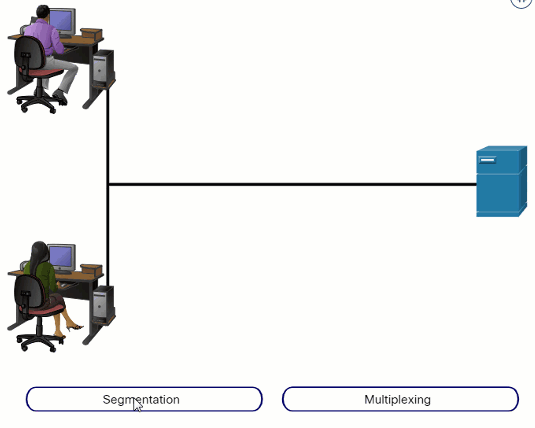
3.6.2. Sequencing
The challenge to using segmentation and multiplexing to transmit messages across a network is the level of complexity that is added to the process. Imagine if you had to send a 100-page letter, but each envelope could only hold one page. Therefore, 100 envelopes would be required and each envelope would need to be addressed individually. It is possible that the 100-page letter in 100 different envelopes arrives out-of-order. Consequently, the information in the envelope would need to include a sequence number to ensure that the receiver could reassemble the pages in the proper order.
In network communications, each segment of the message must go through a similar process to ensure that it gets to the correct destination and can be reassembled into the content of the original message, as shown in the figure. TCP is responsible for sequencing the individual segments.
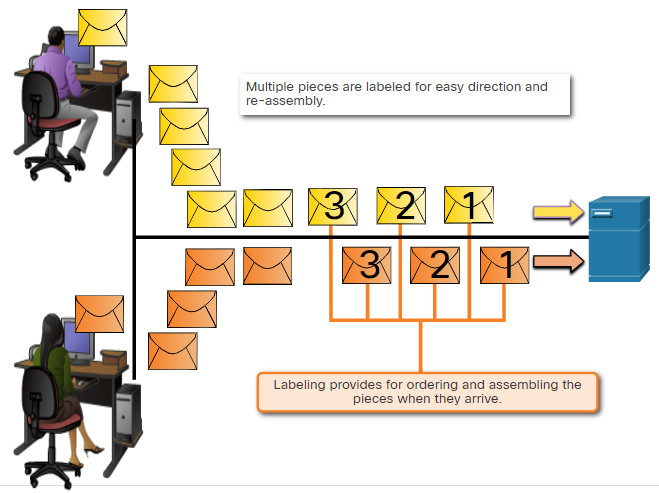
3.6.3. Protocol Data Units
As application data is passed down the protocol stack on its way to be transmitted across the network media, various protocol information is added at each level. This is known as the encapsulation process.
Note: Although the UDP PDU is called datagram, IP packets are sometimes also referred to as IP datagrams.
The form that a piece of data takes at any layer is called a protocol data unit (PDU). During encapsulation, each succeeding layer encapsulates the PDU that it receives from the layer above in accordance with the protocol being used. At each stage of the process, a PDU has a different name to reflect its new functions. Although there is no universal naming convention for PDUs, in this course, the PDUs are named according to the protocols of the TCP/IP suite. The PDUs for each form of data are shown in the figure.
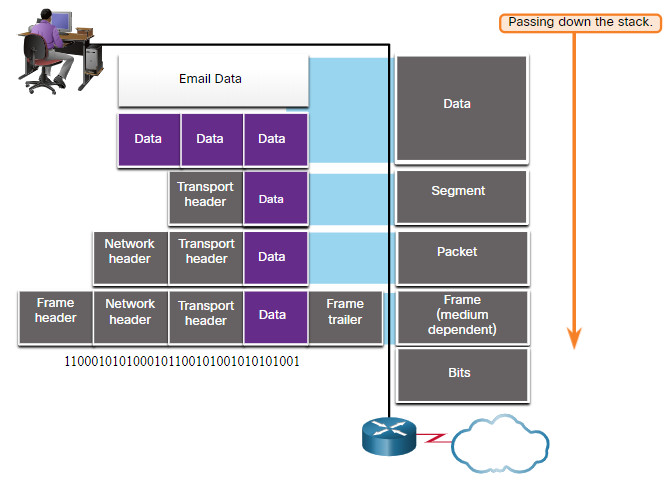
- Data – The general term for the PDU used at the application layer
- Segment – Transport layer PDU
- Packet – Network layer PDU
- Frame – Data Link layer PDU
- Bits – Physical layer PDU used when physically transmitting data over the medium
Note: If the Transport header is TCP, then it is a segment. If the Transport header is UDP then it is a datagram.
3.6.4. Encapsulation Example
When messages are being sent on a network, the encapsulation process works from top to bottom. At each layer, the upper layer information is considered data within the encapsulated protocol. For example, the TCP segment is considered data within the IP packet.

3.6.5. De-encapsulation Example
This process is reversed at the receiving host and is known as de-encapsulation. De-encapsulation is the process used by a receiving device to remove one or more of the protocol headers. The data is de-encapsulated as it moves up the stack toward the end-user application.
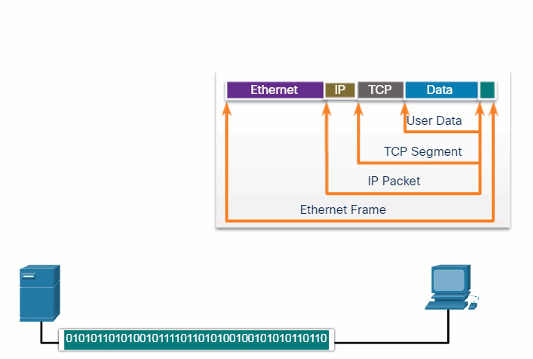
3.7. Data Access
3.7.1. Addresses
As you just learned, it is necessary to segment messages in a network. But those segmented messages will not go anywhere if they are not addressed properly. This topic gives an overview of network addresses. You will also get the chance to use the Wireshark tool, which will help you to ‘view’ network traffic.
The network and data link layers are responsible for delivering the data from the source device to the destination device. As shown in the figure, protocols at both layers contain a source and destination address, but their addresses have different purposes:
- Network layer source and destination addresses – Responsible for delivering the IP packet from the original source to the final destination, which may be on the same network or a remote network.
- Data link layer source and destination addresses – Responsible for delivering the data link frame from one network interface card (NIC) to another NIC on the same network.

3.7.2. Layer 3 Logical Address
An IP address is the network layer, or Layer 3, logical address used to deliver the IP packet from the original source to the final destination, as shown in the figure.

The IP packet contains two IP addresses:
- Source IP address – The IP address of the sending device, which is the original source of the packet.
- Destination IP address – The IP address of the receiving device, which is the final destination of the packet.
The IP addresses indicate the original source IP address and final destination IP address. This is true whether the source and destination are on the same IP network or different IP networks.
An IP address contains two parts:
- Network portion (IPv4) or Prefix (IPv6) – The left-most part of the address that indicates the network in which the IP address is a member. All devices on the same network will have the same network portion of the address.
- Host portion (IPv4) or Interface ID (IPv6) – The remaining part of the address that identifies a specific device on the network. This portion is unique for each device or interface on the network.
Note: The subnet mask (IPv4) or prefix-length (IPv6) is used to identify the network portion of an IP address from the host portion.
3.7.3. Devices on the Same Network
In this example we have a client computer, PC1, communicating with an FTP server on the same IP network.
- Source IPv4 address – The IPv4 address of the sending device, the client computer PC1: 192.168.1.110.
- Destination IPv4 address – The IPv4 address of the receiving device, FTP server: 192.168.1.9.
Notice in the figure that the network portion of both the source IPv4 address and destination IPv4 address are on the same network. Notice in the figure that the network portion of the source IPv4 address and the network portion of the destination IPv4 address are the same and therefore; the source and destination are on the same network.
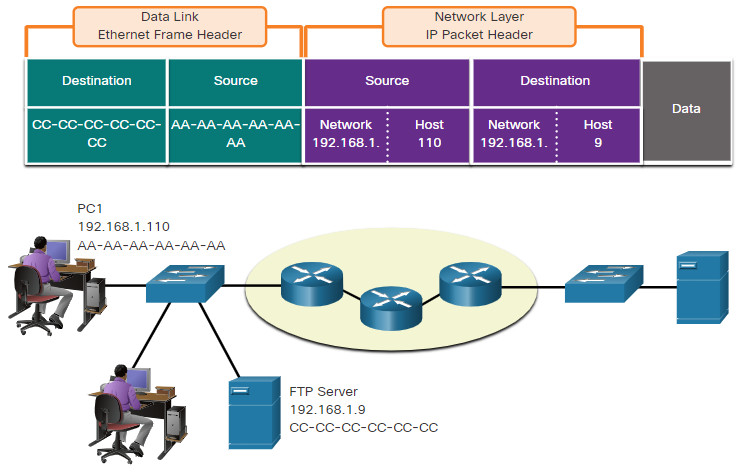
3.7.4. Role of the Data Link Layer Addresses: Same IP Network
When the sender and receiver of the IP packet are on the same network, the data link frame is sent directly to the receiving device. On an Ethernet network, the data link addresses are known as Ethernet Media Access Control (MAC) addresses, as highlighted in the figure.
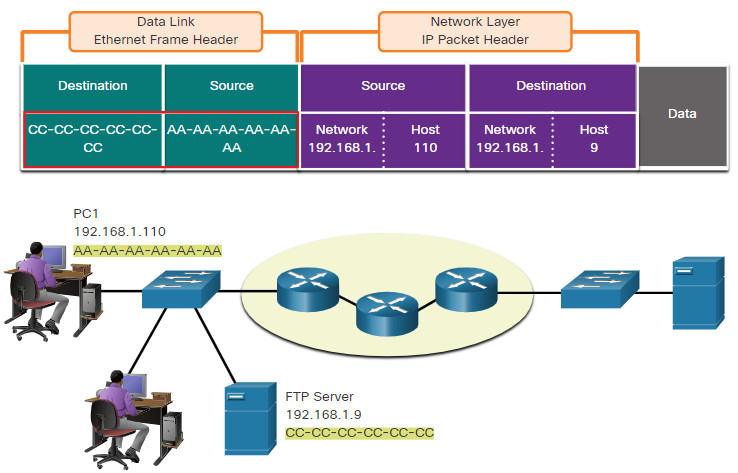
MAC addresses are physically embedded on the Ethernet NIC.
- Source MAC address – This is the data link address, or the Ethernet MAC address, of the device that sends the data link frame with the encapsulated IP packet. The MAC address of the Ethernet NIC of PC1 is AA-AA-AA-AA-AA-AA, written in hexadecimal notation.
- Destination MAC address – When the receiving device is on the same network as the sending device, this is the data link address of the receiving device. In this example, the destination MAC address is the MAC address of the FTP server: CC-CC-CC-CC-CC-CC, written in hexadecimal notation.
The frame with the encapsulated IP packet can now be transmitted from PC1 directly to the FTP server.
3.7.5. Devices on a Remote Network
But what are the roles of the network layer address and the data link layer address when a device is communicating with a device on a remote network? In this example we have a client computer, PC1, communicating with a server, named Web Server, on a different IP network.
3.7.6. Role of the Network Layer Addresses
When the sender of the packet is on a different network from the receiver, the source and destination IP addresses will represent hosts on different networks. This will be indicated by the network portion of the IP address of the destination host.
- Source IPv4 address – The IPv4 address of the sending device, the client computer PC1: 192.168.1.110.
- Destination IPv4 address – The IPv4 address of the receiving device, the server, Web Server: 172.16.1.99.
Notice in the figure that the network portion of the source IPv4 address and destination IPv4 address are on different networks.
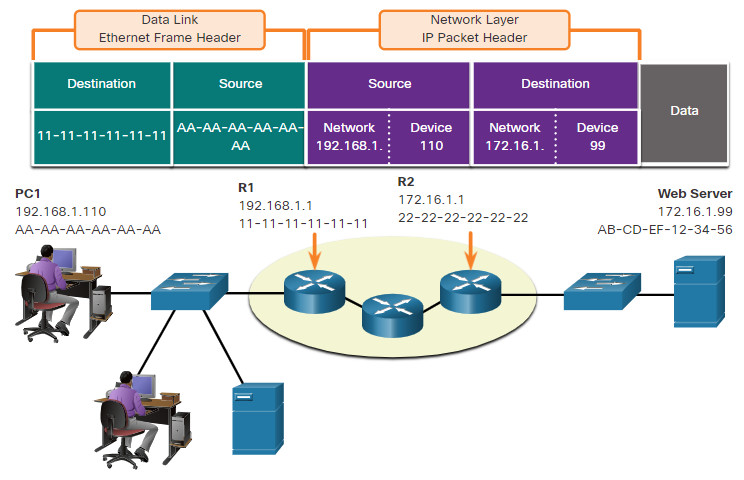
3.7.7. Role of the Data Link Layer Addresses: Different IP Networks
When the sender and receiver of the IP packet are on different networks, the Ethernet data link frame cannot be sent directly to the destination host because the host is not directly reachable in the network of the sender. The Ethernet frame must be sent to another device known as the router or default gateway. In our example, the default gateway is R1. R1 has an Ethernet data link address that is on the same network as PC1. This allows PC1 to reach the router directly.
- Source MAC address – The Ethernet MAC address of the sending device, PC1. The MAC address of the Ethernet interface of PC1 is AA-AA-AA-AA-AA-AA.
- Destination MAC address – When the receiving device, the destination IP address, is on a different network from the sending device, the sending device uses the Ethernet MAC address of the default gateway or router. In this example, the destination MAC address is the MAC address of the R1 Ethernet interface, 11-11-11-11-11-11. This is the interface that is attached to the same network as PC1, as shown in the figure.
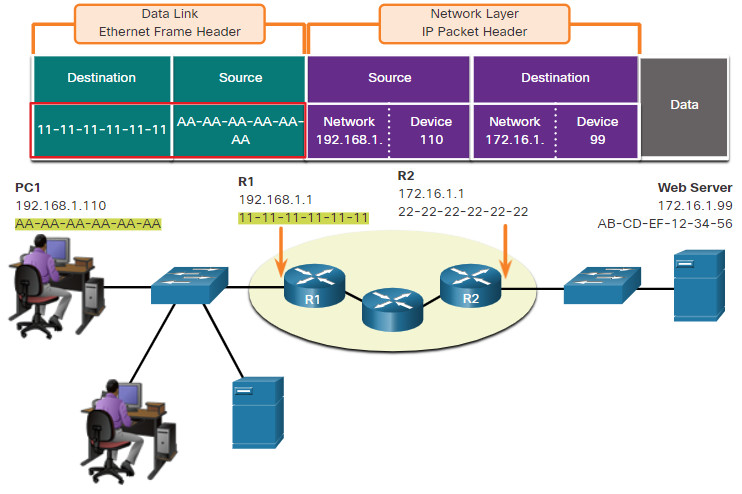
The Ethernet frame with the encapsulated IP packet can now be transmitted to R1. R1 forwards the packet to the destination, Web Server. This may mean that R1 forwards the packet to another router or directly to Web Server if the destination is on a network connected to R1.
It is important that the IP address of the default gateway be configured on each host on the local network. All packets to a destination on remote networks are sent to the default gateway. Ethernet MAC addresses and the default gateway are discussed in more detail in other modules.
3.7.8. Data Link Addresses
The data link Layer 2 physical address has a different role. The purpose of the data link address is to deliver the data link frame from one network interface to another network interface on the same network.
Before an IP packet can be sent over a wired or wireless network, it must be encapsulated in a data link frame, so it can be transmitted over the physical medium.
Host to Router
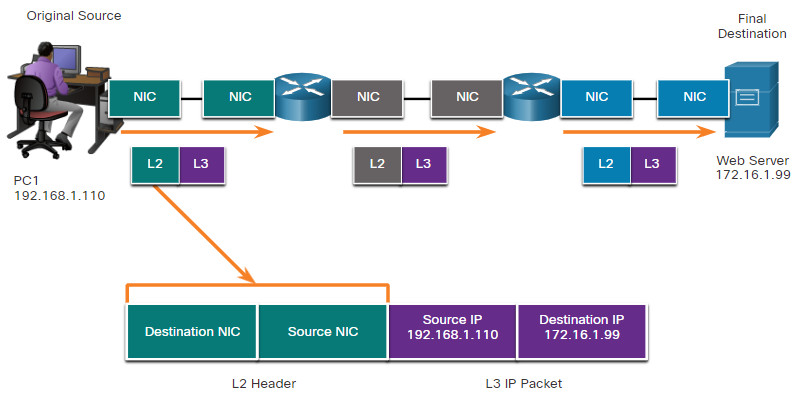
Router to Router

Router to Server
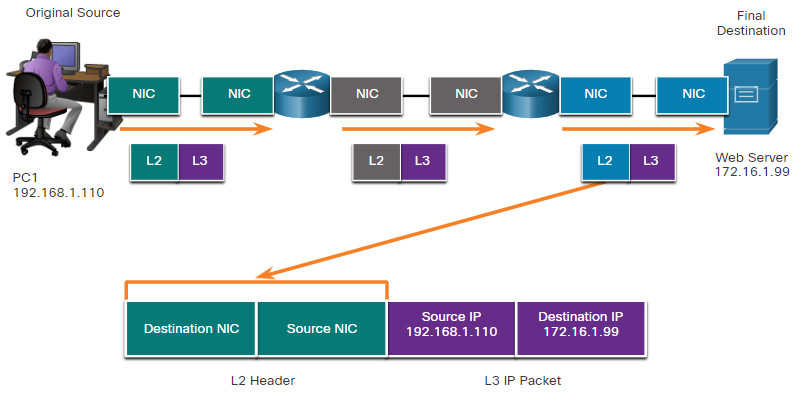
As the IP packet travels from host-to-router, router-to-router, and finally router-to-host, at each point along the way the IP packet is encapsulated in a new data link frame. Each data link frame contains the source data link address of the NIC card sending the frame, and the destination data link address of the NIC card receiving the frame.
The Layer 2, data link protocol is only used to deliver the packet from NIC-to-NIC on the same network. The router removes the Layer 2 information as it is received on one NIC and adds new data link information before forwarding out the exit NIC on its way towards the final destination.
The IP packet is encapsulated in a data link frame that contains the following data link information:
- Source data link address – The physical address of the NIC that is sending the data link frame.
- Destination data link address – The physical address of the NIC that is receiving the data link frame. This address is either the next hop router or the address of the final destination device.
3.7.9. Lab – Install Wireshark
Wireshark is a software protocol analyzer, or “packet sniffer” application, used for network troubleshooting, analysis, software and protocol development, and education. Wireshark is used throughout the course to demonstrate network concepts. In this lab, you will download and install Wireshark.
3.7.10. Lab – Use Wireshark to View Network Traffic
In this lab, you will use Wireshark to capture and analyze traffic.
3.7.10 Lab – Use Wireshark to View Network Traffic
3.8. Module Practice and Quiz
3.8.1. What did I learn in this module?
The Rules
All communication methods have three elements in common: message source (sender), message destination (receiver), and channel. Sending a message is governed by rules called protocols. Protocols must include: an identified sender and receiver, common language and grammar, speed and timing of delivery, and confirmation or acknowledgment requirements. Common computer protocols include these requirements: message encoding, formatting and encapsulation, size, timing, and delivery options. Encoding is the process of converting information into another acceptable form, for transmission. Decoding reverses this process to interpret the information. Message formats depend on the type of message and the channel that is used to deliver the message. Message timing includes flow control, response timeout, and access method. Message delivery options include unicast, multicast, and broadcast.
Protocols
Protocols are implemented by end-devices and intermediary devices in software, hardware, or both. A message sent over a computer network typically requires the use of several protocols, each one with its own functions and format. Each network protocol has its own function, format, and rules for communications. The Ethernet family of protocols includes IP, TCP, HTTP, and many more. Protocols secure data to provide authentication, data integrity, and data encryption: SSH, SSL, and TLS. Protocols enable routers to exchange route information, compare path information, and then to select the best path to the destination network: OSPF and BGP. Protocols are used for the automatic detection of devices or services: DHCP and DNS. Computers and network devices use agreed-upon protocols that provide the following functions: addressing, reliability, flow control, sequencing, error-detection, and application interface.
Protocol Suites
A protocol suite is a group of inter-related protocols necessary to perform a communication function. A protocol stack shows how the individual protocols within a suite are implemented. Since the 1970s there have been several different protocol suites, some developed by a standards organization and others developed by various vendors. TCP/IP protocols are available for the application, transport, and internet layers. TCP/IP is the protocol suite used by today’s networks and internet. TCP/IP offers two important aspects to vendors and manufacturers: open standard protocol suite, and standards-based protocol suite. The TCP/IP protocol suite communication process enables such processes as a web server encapsulating and sending a web page to a client, as well as the client de-encapsulating the web page for display in a web browser.
Standards Organizations
Open standards encourage interoperability, competition, and innovation. Standards organizations are usually vendor-neutral, non-profit organizations established to develop and promote the concept of open standards. Various organizations have different responsibilities for promoting and creating standards for the internet including: ISOC, IAB, IETF, and IRTF. Standards organizations that develop and support TCP/IP include: ICANN and IANA. Electronic and communications standards organizations include: IEEE, EIA, TIA, and ITU-T.
Reference Models
The two reference models that are used to describe network operations are OSI and TCP/IP. The OSI model has seven layers:
7 – Application
6 – Presentation
5 – Session
4 – Transport
3 – Network
2 – Data Link
1 – Physical
The TCP/IP model has four layers:
4 – Application
3 – Transport
2 – Internet
1 – Network Access
Data Encapsulation
Segmenting messages has two primary benefits:
- By sending smaller individual pieces from source to destination, many different conversations can be interleaved on the network. This is called multiplexing.
- Segmentation can increase the efficiency of network communications. If part of the message fails to make it to the destination only the missing parts need to be retransmitted.
TCP is responsible for sequencing the individual segments. The form that a piece of data takes at any layer is called a protocol data unit (PDU). During encapsulation, each succeeding layer encapsulates the PDU that it receives from the layer above in accordance with the protocol being used. When sending messages on a network, the encapsulation process works from top to bottom. This process is reversed at the receiving host and is known as de-encapsulation. De-encapsulation is the process used by a receiving device to remove one or more of the protocol headers. The data is de-encapsulated as it moves up the stack toward the end-user application.
Data Access
The network and data link layers are responsible for delivering the data from the source device to the destination device. Protocols at both layers contain a source and destination address, but their addresses have different purposes:
- Network layer source and destination addresses – Responsible for delivering the IP packet from the original source to the final destination, which may be on the same network or a remote network.
- Data link layer source and destination addresses – Responsible for delivering the data link frame from one network interface card (NIC) to another NIC on the same network.
The IP addresses indicate the original source IP address and final destination IP address. An IP address contains two parts: the network portion (IPv4) or Prefix (IPv6) and the host portion (IPv4) or Interface ID (IPv6). When the sender and receiver of the IP packet are on the same network, the data link frame is sent directly to the receiving device. On an Ethernet network, the data link addresses are known as Ethernet Media Access Control (MAC) addresses. When the sender of the packet is on a different network from the receiver, the source and destination IP addresses will represent hosts on different networks. The Ethernet frame must be sent to another device known as the router or default gateway.

Hello,
I am a registered user, I log in but the page says:
‘This content is for active members only.’
What do I need to do to access the content?
Thanks
Hi! You need to pay to access this content.